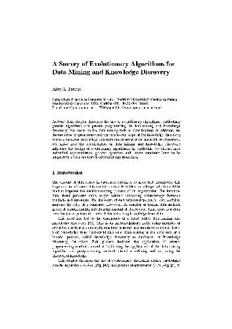
A Survey of Evolutionary Algorithms for Data Mining and Knowledge Discovery PDF
Preview A Survey of Evolutionary Algorithms for Data Mining and Knowledge Discovery
A Survey of Evolutionary Algorithms for Data Mining and Knowledge Discovery Alex A. Freitas Postgraduate Program in Computer Science, Pontificia Universidade Catolica do Parana Rua Imaculada Conceicao, 1155. Curitiba - PR. 80215-901. Brazil. E-mail: alex@ppgia.pucpr.br Web page: http://www.ppgia.pucpr.br/~alex Abstract: This chapter discusses the use of evolutionary algorithms, particularly genetic algorithms and genetic programming, in data mining and knowledge discovery. We focus on the data mining task of classification. In addition, we discuss some preprocessing and postprocessing steps of the knowledge discovery process, focusing on attribute selection and pruning of an ensemble of classifiers. We show how the requirements of data mining and knowledge discovery influence the design of evolutionary algorithms. In particular, we discuss how individual representation, genetic operators and fitness functions have to be adapted for extracting high-level knowledge from data. 1. Introduction The amount of data stored in databases continues to grow fast. Intuitively, this large amount of stored data contains valuable hidden knowledge, which could be used to improve the decision-making process of an organization. For instance, data about previous sales might contain interesting relationships between products and customers. The discovery of such relationships can be very useful to increase the sales of a company. However, the number of human data analysts grows at a much smaller rate than the amount of stored data. Thus, there is a clear need for (semi-)automatic methods for extracting knowledge from data. This need has led to the emergence of a field called data mining and knowledge discovery [66]. This is an interdisciplinary field, using methods of several research areas (specially machine learning and statistics) to extract high- level knowledge from real-world data sets. Data mining is the core step of a broader process, called knowledge discovery in databases, or knowledge discovery, for short. This process includes the application of several preprocessing methods aimed at facilitating the application of the data mining algorithm and postprocessing methods aimed at refining and improving the discovered knowledge. This chapter discusses the use of evolutionary algorithms (EAs), particularly genetic algorithms (GAs) [29], [47] and genetic programming (GP) [41], [6], in data mining and knowledge discovery. We focus on the data mining task of classification, which is the task addressed by most EAs that extract high-level knowledge from data. In addition, we discuss the use of EAs for performing some preprocessing and postprocessing steps of the knowledge discovery process, focusing on attribute selection and pruning of an ensemble of classifiers. We show how the requirements of data mining and knowledge discovery influence the design of EAs. In particular, we discuss how individual representation, genetic operators and fitness functions have to be adapted for extracting high-level knowledge from data. This chapter is organized as follows. Section 2 presents an overview of data mining and knowledge discovery. Section 3 discusses several aspects of the design of GAs for rule discovery. Section 4 discusses GAs for performing some preprocessing and postprocessing steps of the knowledge discovery process. Section 5 addresses the use of GP in rule discovery. Section 6 addresses the use of GP in the preprocessing phase of the knowledge discovery process. Finally, section 7 presents a discussion that concludes the chapter. 2. An Overview of Data Mining and Knowledge Discovery This section is divided into three parts. Subsection 2.1 discusses the desirable properties of discovered knowledge. Subsection 2.2 reviews the main data mining tasks. Subsection 2.3 presents an overview of the knowledge discovery process. 2.1 The Desirable Properties of Discovered Knowledge In essence, data mining consists of the (semi-)automatic extraction of knowledge from data. This statement raises the question of what kind of knowledge we should try to discover. Although this is a subjective issue, we can mention three general properties that the discovered knowledge should satisfy; namely, it should be accurate, comprehensible, and interesting. Let us briefly discuss each of these properties in turn. (See also section 3.3.) As will be seen in the next subsection, in data mining we are often interested in discovering knowledge which has a certain predictive power. The basic idea is to predict the value that some attribute(s) will take on in “the future”, based on previously observed data. In this context, we want the discovered knowledge to have a high predictive accuracy rate. We also want the discovered knowledge to be comprehensible for the user. This is necessary whenever the discovered knowledge is to be used for supporting a decision to be made by a human being. If the discovered “knowledge” is just a black box, which makes predictions without explaining them, the user may not trust it [48]. Knowledge comprehensibility can be achieved by using high-level knowledge representations. A popular one, in the context of data mining, is a set of IF-THEN (prediction) rules, where each rule is of the form: IF <some_conditions_are_satisfied> THEN <predict_some_value_for_an_attribute> The third property, knowledge interestingness, is the most difficult one to define and quantify, since it is, to a large extent, subjective. However, there are some aspects of knowledge interestingness that can be defined in objective terms. The topic of rule interestingness, including a comparison between the subjective and the objective approaches for measuring rule interestingness, will be discussed in section 2.3.2. 2.2 Data Mining Tasks In this section we briefly review some of the main data mining tasks. Each task can be thought of as a particular kind of problem to be solved by a data mining algorithm. Other data mining tasks are briefly discussed in [18], [25]. 2.2.1 Classification. This is probably the most studied data mining task. It has been studied for many decades by the machine learning and statistics communities (among others). In this task the goal is to predict the value (the class) of a user-specified goal attribute based on the values of other attributes, called the predicting attributes. For instance, the goal attribute might be the Credit of a bank customer, taking on the values (classes) “good” or “bad”, while the predicting attributes might be the customer’s Age, Salary, Current_account_balance, whether or not the customer has an Unpaid Loan, etc. Classification rules can be considered a particular kind of prediction rules where the rule antecedent (“IF part”) contains a combination - typically, a conjunction - of conditions on predicting attribute values, and the rule consequent (“THEN part”) contains a predicted value for the goal attribute. Examples of classification rules are: IF (Unpaid_Loan? = “no”) and (Current_account_balance > $3,000) THEN (Credit = “good”) IF (Unpaid_Loan? = “yes”) THEN (Credit = “bad”) In the classification task the data being mined is divided into two mutually exclusive and exhaustive data sets, the training set and the test set. The data mining algorithm has to discover rules by accessing the training set only. In order to do this, the algorithm has access to the values of both the predicting attributes and the goal attribute of each example (record) in the training set. Once the training process is finished and the algorithm has found a set of classification rules, the predictive performance of these rules is evaluated on the test set, which was not seen during training. This is a crucial point. Actually, it is trivial to get 100% of predictive accuracy in the training set by completely sacrificing the predictive performance on the test set, which would be useless. To see this, suppose that for a training set with n examples the data mining algorithm “discovers” n rules, i.e. one rule for each training example, such that, for each “discovered” rule: (a) the rule antecedent contains conditions with exactly the same attribute-value pairs as the corresponding training example; (b) the class predicted by the rule consequent is the same as the actual class of the corresponding training example. In this case the “discovered” rules would trivially achieve a 100% of predictive accuracy on the training set, but would be useless for predicting the class of examples unseen during training. In other words, there would be no generalization, and the “discovered” rules would be capturing only idiosyncrasies of the training set, or just “memorizing” the training data. In the parlance of machine learning and data mining, the rules would be overfitting the training data. For a comprehensive discussion about how to measure the predictive accuracy of classification rules, the reader is referred to [34], [67]. In the next three subsections we briefly review the data mining tasks of dependence modeling, clustering and discovery of association rules. Our main goal is to compare these tasks against the task of classification, since space limitations do not allow us to discuss these tasks in more detail. 2.2.2 Dependence Modeling. This task can be regarded as a generalization of the classification task. In the former we want to predict the value of several attributes - rather than a single goal attribute, as in classification. We focus again on the discovery of prediction (IF-THEN) rules, since this is a high-level knowledge representation. In its most general form, any attribute can occur both in the antecedent (“IF part”) of a rule and in the consequent (“THEN part”) of another rule - but not in both the antecedent and the consequent of the same rule. For instance, we might discover the following two rules: IF (Current_account_balance > $3,000) AND (Salary = “high”) THEN (Credit = “good”) IF (Credit = “good”) AND (Age > 21) THEN (Grant_Loan? = “yes”) In some cases we want to restrict the use of certain attributes to a given part (antecedent or consequent) of a rule. For instance, we might specify that the attribute Credit can occur only in the consequent of a rule, or that the attribute Age can occur only in the antecedent of a rule. For the purposes of this chapter we assume that in this task, similarly to the classification task, the data being mined is partitioned into training and test sets. Once again, we use the training set to discover rules and the test set to evaluate the predictive performance of the discovered rules. 2.2.3 Clustering. As mentioned above, in the classification task the class of a training example is given as input to the data mining algorithm, characterizing a form of supervised learning. In contrast, in the clustering task the data mining algorithm must, in some sense, “discover” classes by itself, by partitioning the examples into clusters, which is a form of unsupervised learning [19], [20]. Examples that are similar to each other (i.e. examples with similar attribute values) tend to be assigned to the same cluster, whereas examples different from each other tend to be assigned to distinct clusters. Note that, once the clusters are found, each cluster can be considered as a “class”, so that now we can run a classification algorithm on the clustered data, by using the cluster name as a class label. GAs for clustering are discussed e.g. in [50], [17], [33]. 2.2.4 Discovery of Association Rules. In the standard form of this task (ignoring variations proposed in the literature) each data instance (or “record”) consists of a set of binary attributes called items. Each instance usually corresponds to a customer transaction, where a given item has a true or false value depending on whether or not the corresponding customer bought that item in that transaction. An association rule is a relationship of the form IF X THEN Y, where X and Y are sets of items and X ∩ Y = ∅ [1], [2]. An example is the association rule: IF fried_potatoes THEN soft_drink, ketchup . Although both classification and association rules have an IF-THEN structure, there are important differences between them. We briefly mention here two of these differences. First, association rules can have more than one item in the rule consequent, whereas classification rules always have one attribute (the goal one) in the consequent. Second, unlike the association task, the classification task is asymmetric with respect to the predicting attributes and the goal attribute. Predicting attributes can occur only in the rule antecedent, whereas the goal attribute occurs only in the rule consequent. A more detailed discussion about the differences between classification and association rules can be found in [24]. 2.3 The Knowledge Discovery Process The application of a data mining algorithm to a data set can be considered the core step of a broader process, often called the knowledge discovery process [18]. In addition to the data mining step itself, this process also includes several other steps. For the sake of simplicity, these additional steps can be roughly categorized into data preprocessing and discovered-knowledge postprocessing. We use the term data preprocessing in a general sense, including the following steps (among others) [55]: (a) Data Integration - This is necessary if the data to be mined comes from several different sources, such as several departments of an organization. This step involves, for instance, removing inconsistencies in attribute names or attribute value names between data sets of different sources. (b) Data Cleaning - It is important to make sure that the data to be mined is as accurate as possible. This step may involve detecting and correcting errors in the data, filling in missing values, etc. Data cleaning has a strong overlap with data integration, if this latter is also performed. It is often desirable to involve the user in data cleaning and data integration, so that (s)he can bring her/his background knowledge into these tasks. Some data cleaning methods for data mining are discussed in [32], [59]. (c) Discretization - This step consists of transforming a continuous attribute into a categorical (or nominal) attribute, taking on only a few discrete values - e.g., the real-valued attribute Salary can be discretized to take on only three values, say “low”, “medium”, and “high”. This step is particularly required when the data mining algorithm cannot cope with continuous attributes. In addition, discretization often improves the comprehensibility of the discovered knowledge [11], [52]. (d) Attribute Selection - This step consists of selecting a subset of attributes relevant for classification, among all original attributes. It will be discussed in subsection 2.3.1. Discovered-knowledge postprocessing usually aims at improving the comprehensibility and/or the interestingness of the knowledge to be shown to the user. This step may involve, for instance, the selection of the most interesting rules, among the discovered rule set. This step will be discussed in subsection 2.3.2. Note that the knowledge discovery process is inherently iterative, as illustrated in Fig. 1. As can be seen in this figure, the output of a step can be not only sent to the next step in the process, but also sent – as a feedback - to a previous step. input data . . pre- data post- integration proc. mining p roc. . output input data knowledge Fig. 1 . An overview of the knowledge discovery process 2.3.1 Attribute Selection. This consists of selecting, among all the attributes of the data set, a subset of attributes relevant for the target data mining task. Note that a number of data mining algorithms, particularly rule induction ones, already perform a kind of attribute selection when they discover a rule containing just a few attributes, rather than all attributes. However, in this section we are interested in attribute selection as a preprocessing step for the data mining algorithm. Hence, we first select an attribute subset and then give only the selected attributes for the data mining algorithm. The motivation for this kind of preprocessing is the fact that irrelevant attributes can somehow “confuse” the data mining algorithm, leading to the discovery of inaccurate or useless knowledge [38]. Considering an extreme example, suppose we try to predict whether the credit of a customer is good or bad, and suppose that the data set includes the attribute Customer_Name. A data mining algorithm might discover too specific rules of the form: IF (Customer_Name = “a_specific_name”) THEN (Credit = “good”). This kind of rule has no predictive power. Most likely, it covers a single customer and cannot be generalized to other customers. Technically speaking, it is overfitting the data. To avoid this problem, the attribute Customer_Name (and other attributes having a unique value for each training example) should be removed in a preprocessing step. Attribute selection methods can be divided into filter and wrapper approaches. In the filter approach the attribute selection method is independent of the data mining algorithm to be applied to the selected attributes. By contrast, in the wrapper approach the attribute selection method uses the result of the data mining algorithm to determine how good a given attribute subset is. In essence, the attribute selection method iteratively generates attribute subsets (candidate solutions) and evaluates their qualities, until a termination criterion is satisfied. The attribute-subset generation procedure can be virtually any search method. The major characteristic of the wrapper approach is that the quality of an attribute subset is directly measured by the performance of the data mining algorithm applied to that attribute subset. The wrapper approach tends to be more effective than the filter one, since the selected attributes are “optimized” for the data mining algorithm. However, the wrapper approach tends to be much slower than the filter approach, since in the former a full data mining algorithm is applied to each attribute subset considered by the search. In addition, if we want to apply several data mining algorithms to the data, the wrapper approach becomes even more computationally expensive, since we need to run the wrapper procedure once for each data mining algorithm. 2.3.2 Discovered-Knowledge Postprocessing. It is often the case that the knowledge discovered by a data mining algorithm needs to undergo some kind of postprocessing. Since in this chapter we focus on discovered knowledge expressed as IF-THEN prediction rules, we are mainly interested in the postprocessing of a discovered rule set. There are two main motivations for such postprocessing. First, when the discovered rule set is large, we often want to simplify it - i.e., to remove some rules and/or rule conditions - in order to improve knowledge comprehensibility for the user. Second, we often want to extract a subset of interesting rules, among all discovered ones. The reason is that although many data mining algorithms were designed to discover accurate, comprehensible rules, most of these algorithms were not designed to discover interesting rules, which is a rather more difficult and ambitious goal, as mentioned in section 2.1. Methods for selection of interesting rules can be roughly divided into subjective and objective methods. Subjective methods are user-driven and domain-dependent. For instance, the user may specify rule templates, indicating which combination of attributes must occur in the rule for it to be considered interesting - this approach has been used mainly in the context of association rules [40]. As another example of a subjective method, the user can give the system a general, high-level description of his/her previous knowledge about the domain, so that the system can select only the discovered rules which represent previously-unknown knowledge for the user [44]. By contrast, objective methods are data-driven and domain-independent. Some of these methods are based on the idea of comparing a discovered rule against other rules, rather than against the user’s beliefs. In this case the basic idea is that the interestingness of a rule depends not only on the quality of the rule itself, but also on its similarity to other rules. Some objective measures of rule interestingness are discussed in [26], [22], [23]. We believe that ideally a combination of subjective and objective approaches should be used to try to solve the very hard problem of returning interesting knowledge to the user. 3. Genetic Algorithms (GAs) for Rule Discovery In general the main motivation for using GAs in the discovery of high-level prediction rules is that they perform a global search and cope better with attribute interaction than the greedy rule induction algorithms often used in data mining [14]. In this section we discuss several aspects of GAs for rule discovery. This section is divided into three parts. Subsection 3.1 discusses how one can design an individual to represent prediction (IF-THEN) rules. Subsection 3.2 discusses how genetic operators can be adapted to handle individuals representing rules. Section 3.3 discusses some issues involved in the design of fitness functions for rule discovery. 3.1 Individual Representation 3.1.1 Michigan versus Pittsburgh Approach. Genetic algorithms (GAs) for rule discovery can be divided into two broad approaches, based on how rules are encoded in the population of individuals (“chromosomes”). In the Michigan approach each individual encodes a single prediction rule, whereas in the Pittsburgh approach each individual encodes a set of prediction rules. It should be noted that some authors use the term “Michigan approach” in a narrow sense, to refer only to classifier systems [35], where rule interaction is taken into account by a specific kind of credit assignment method. However, we use the term “Michigan approach” in a broader sense, to denote any approach where each GA individual encodes a single prediction rule. The choice between these two approaches strongly depends on which kind of rule we want to discover. This is related to which kind of data mining task we are addressing. Suppose the task is classification. Then we usually evaluate the quality of the rule set as a whole, rather than the quality of a single rule. In other words, the interaction among the rules is important. In this case, the Pittsburgh approach seems more natural. On the other hand, the Michigan approach might be more natural in other kinds of data mining tasks. An example is a task where the goal is to find a small set of high-quality prediction rules, and each rule is often evaluated independently of other rules [49]. Another example is the task of detecting rare events [65]. Turning back to classification, which is the focus of this chapter, in a nutshell the pros and cons of each approach are as follows. The Pittsburgh approach directly takes into account rule interaction when computing the fitness function of an individual. However, this approach leads to syntactically-longer individuals, which tends to make fitness computation more computationally expensive. In addition, it may require some modifications to standard genetic operators to cope with relatively complex individuals. Examples of GAs for classification which follow the Pittsburgh approach are GABIL [13], GIL [37], and HDPDCS [51]. By contrast, in the Michigan approach the individuals are simpler and syntactically shorter. This tends to reduce the time taken to compute the fitness function and to simplify the design of genetic operators. However, this advantage comes with a cost. First of all, since the fitness function evaluates the quality of each rule separately, now it is not easy to compute the quality of the rule set as a whole - i.e. taking rule interactions into account. Another problem is that, since we want to discover a set of rules, rather than a single rule, we cannot allow the GA population to converge to a single individual - which is what usually happens in standard GAs. This introduces the need for some kind of niching method [45], which obviously is not necessary in the case of the Pittsburgh approach. We can avoid the need for niching in the Michigan approach by running the GA several times, each time discovering a different rule. The drawback of this approach is that it tends to be computationally expensive. Examples of GAs for classification which follow the Michigan approach are COGIN [30] and REGAL [28]. So far we have seen that an individual of a GA can represent a single rule or several rules, but we have not said yet how the rule(s) is(are) encoded in the genome of the individual. We now turn to this issue. To follow our discussion, assume that a rule has the form “IF cond AND ... AND cond THEN class = c“, 1 n i where cond ... cond are attribute-value conditions (e.g. Sex = “M”) and c is the 1 n i class predicted by the rule. We divide our discussion into two parts, the representation of the rule antecedent (the “IF” part of the rule) and the representation of the rule consequent (the “THEN” part of the rule). These two issues are discussed in the next two subsections. In these subsections we will assume that the GA follows the Michigan approach, to simplify our discussion. However, most of the ideas in these two subsections can be adapted to the Pittsburgh approach as well. 3.1.2 Representing the Rule Antecedent (a Conjunction of Conditions). A simple approach to encode rule conditions into an individual is to use a binary encoding. Suppose that a given attribute can take on k discrete values. Then we can encode a condition on the value of this attribute by using k bits. The i-th value (i=1,...,k) of the attribute domain is part of the rule condition if and only if the i-th bit is “on” [13]. For instance, suppose that a given individual represents a rule antecedent with a single attribute-value condition, where the attribute is Marital_Status and its values can be “single”, “married”, “divorced” and “widow”. Then a condition involving this attribute would be encoded in the genome by four bits. If these bits take on, say, the values “0 1 1 0” then they would be representing the following rule antecedent: IF (Marital_Status = “married” OR “divorced”) Hence, this encoding scheme allows the representation of conditions with internal disjunctions, i.e. with the logical OR operator within a condition. Obviously, this encoding scheme can be easily extended to represent rule antecedents with several conditions (linked by a logical AND) by including in the genome an appropriate number of bits to represent each attribute-value condition. Note that if all the k bits of a given rule condition are “on”, this means that the corresponding attribute is effectively being ignored by the rule antecedent, since any value of the attribute satisfies the corresponding rule condition. In practice, it is desirable to favor rules where some conditions are “turned off” - i.e. have all their bits set to “1” – in order to reduce the size of the rule antecedent. (Recall that we want comprehensible rules and, in general, the shorter the rule is the more comprehensible it is.) To achieve this, one can automatically set all bits of a condition to “1” whenever more than half of those bits are currently set to “1”. Another technique to achieve the same effect will be discussed at the end of this subsection. The above discussion assumed that the attributes were categorical, also called nominal or discrete. In the case of continuous attributes the binary encoding mechanism gets slightly more complex. A common approach is to use bits to represent the value of a continuous attribute in binary notation. For instance, the binary string “0 0 0 0 1 1 0 1” represents the value 13 of a given integer-valued attribute. Instead of using a binary representation for the genome of an individual, this genome can be expressed in a higher-level representation which directly encodes the rule conditions. One of the advantages of this representation is that it leads to a more uniform treatment of categorical and continuous attributes, in comparison
The list of books you might like

Believe Me

The Sweetest Oblivion (Made Book 1)

The 48 Laws of Power

A Thousand Boy Kisses
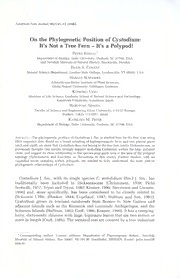
On the Phylogenetic Position of Cystodium: It's Not a Tree Fern – It's a Polypod!

Crime Scene Investigation
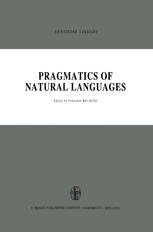
Pragmatics of Natural Languages

C anton © bser U cr

Stimme und Sprache

C anton €>b£crUer
![Quantenmechanik [Quantum Mech - IN GERMAN] book image](https://cdn.pdfdrive.to/media/content/thumbnails/c339d3e1-fb21-49fc-9adc-8c827d6bafd0.webp)
Quantenmechanik [Quantum Mech - IN GERMAN]
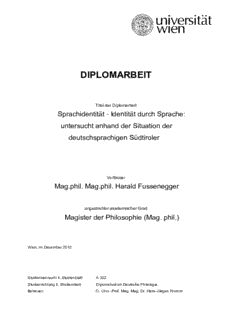
Südtirol/Alto Adige/Südtirol

The Brooklyn Paper Volume 29 Issue 40
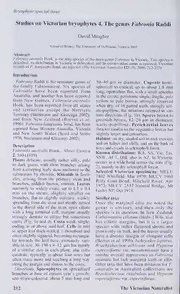
Studies on Victorian Bryophytes 4. The Genus 'Fabronia' Raddi

C APA TERMO DE MARIANA.cdr
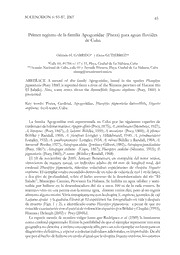
Primer registro de la familia Apogonidae (Pisces) para aguas fluviáles de Cuba
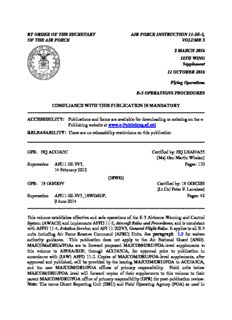
BY ORDER OF THE SECRETARY OF THE AIR FORCE AIR FORCE INSTRUCTION 11-2E-3 ...

The Art of SXO: Placing UX Design Methods into SEO Best Practices (Design Thinking)

Jack of Hearts: Hunting Lee Child's Jack Reacher (The Hunt for Jack Reacher Series Book 15)
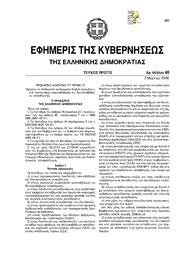
Greek Government Gazette: Part 1, 2006 no. 48

Farzana the woman who saved an empire

O Evangelho segundo o Espiritismo
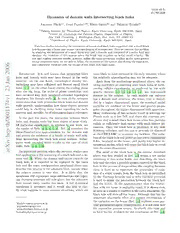
![ERIC ED495088: U. S. Intel[R] Teach to the Future Essentials Course: 2006 End of School Year Survey. Key Findings book image](https://cdn.pdfdrive.to/media/content/thumbnails/ae4a90db-8ebb-4369-ad81-e2c759129109.webp)
